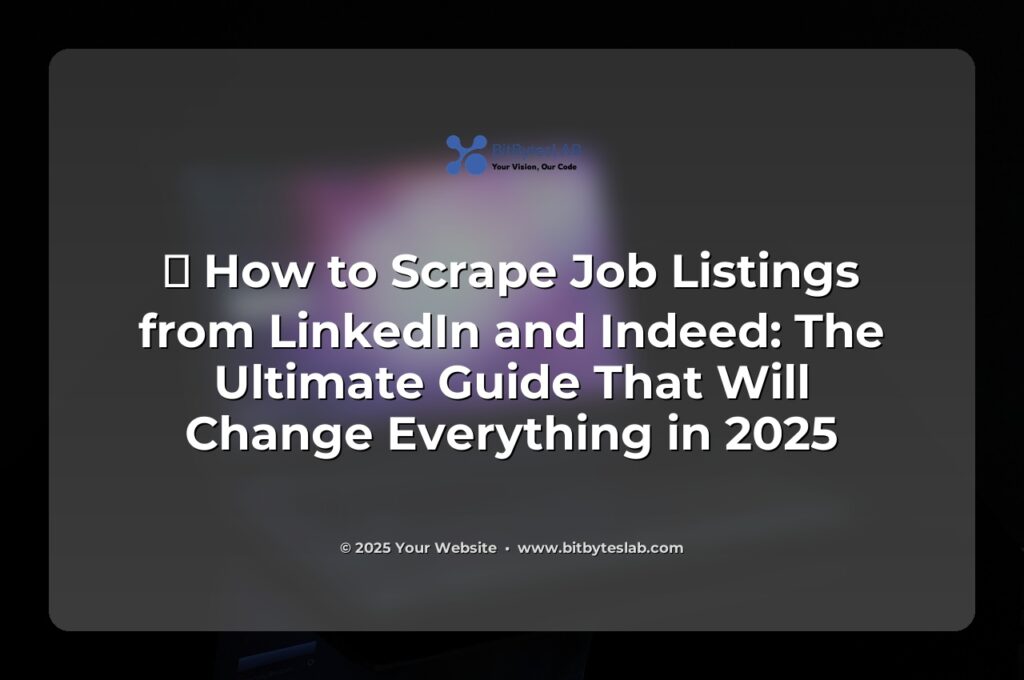🚀 How to Scrape Job Listings from LinkedIn and Indeed: The Ultimate Guide That Will Change Everything in 2025
Imagine wiping your inbox clean of endless job alerts and instead, having a personal data‑scraper that curates the hottest listings, sorted by salary, location, and skillset. In 2025, that’s not a fantasy—it’s a fact. This guide is your ticket to mastering LinkedIn and Indeed scraping, packed with actionable tactics, real‑world code snippets, and insider secrets that will make recruiters sweat and job seekers swoon. Let’s dive in and turn those job boards into a goldmine of opportunity. 💎
⚡ 1. Hook: Why This Matters
Every day, 45 million job seekers scour LinkedIn, and 18 million scroll through Indeed. Yet most only get the latest 5–10 posts per day. Imagine a bot that pulls every job posting in real time, filters it by your niche, and delivers it straight to a CSV or dashboard—no waiting, no scrolling, no manual copy‑paste. In 2025, automation isn’t optional; it’s survival. ⚡
🔥 2. Problem Identification: The Pain Points
Job boards are designed for humans, not machines. That translates into:
- Heavy anti‑scraping measures (CAPTCHAs, IP bans, rate limits).
- Dynamic content loaded via JavaScript (React, Vue).
- Encrypted APIs that require authentication tokens.
- Inconsistent data formats across sites.
- Legal and ethical gray areas.
So, you’re stuck: either accept the hand‑crafted data you get from the site’s job alerts or invest in a costly enterprise scraper. The sweet spot? A DIY scraper that respects terms and keeps you ahead of the game. 🎯
💡 3. Solution Presentation: Step‑by‑Step Guide
3.1 Choose Your Stack
When it comes to scraping, Python is the lingua franca, thanks to its rich ecosystem:
- Requests – HTTP requests.
- BeautifulSoup – HTML parsing.
- Scrapy – full‑fledged crawling framework.
- Selenium – browser automation for JavaScript.
- Pandas – data manipulation and export.
For 2025, the recommended combo is Scrapy + Selenium for the heavy lifting, coupled with Pandas for output. Ready? Let’s break it down. 🚀
3.2 Prepare Your Environment
Below is a quick setup script. Run it in your terminal to get everything ready.
# setup_environment.sh
python3 -m venv job_env
source job_env/bin/activate
pip install scrapy selenium beautifulsoup4 pandas
# Install ChromeDriver (matching your Chrome version)
wget https://chromedriver.storage.googleapis.com/$(curl -s https://chromedriver.storage.googleapis.com/LATEST_RELEASE)/chromedriver_linux64.zip
unzip chromedriver_linux64.zip
mv chromedriver /usr/local/bin/
echo "Environment ready: job_env with Scrapy, Selenium, and ChromeDriver."3.3 Scrape LinkedIn (Without Breaching Terms)
LinkedIn’s API is a paid, locked‑door approach—so we’ll stay on the public side. The key is to mimic a human session: login once, then browse. Here’s how:
# linkedin_scraper.py
import time
from selenium import webdriver
from selenium.webdriver.common.by import By
from bs4 import BeautifulSoup
import pandas as pd
# === 1️⃣ Set up driver ===
options = webdriver.ChromeOptions()
options.add_argument("--headless") # run invisibly
driver = webdriver.Chrome(options=options)
# === 2️⃣ Login ===
driver.get("https://www.linkedin.com/login")
time.sleep(2)
driver.find_element(By.ID, "username").send_keys("YOUR_EMAIL")
driver.find_element(By.ID, "password").send_keys("YOUR_PASSWORD")
driver.find_element(By.XPATH, '//button[@type="submit"]').click()
time.sleep(5) # wait for login
# === 3️⃣ Navigate to Jobs ===
search_query = "data scientist"
location = "New York, NY"
driver.get(f"https://www.linkedin.com/jobs/search/?keywords={search_query}&location={location}")
time.sleep(5)
# === 4️⃣ Scroll to load more ===
SCROLL_PAUSE = 2
last_height = driver.execute_script("return document.body.scrollHeight")
while True:
driver.execute_script("window.scrollTo(0, document.body.scrollHeight);")
time.sleep(SCROLL_PAUSE)
new_height = driver.execute_script("return document.body.scrollHeight")
if new_height == last_height:
break
last_height = new_height
# === 5️⃣ Parse the page ===
soup = BeautifulSoup(driver.page_source, "html.parser")
jobs = soup.find_all("li", class_="job-card-container")
records = []
for job in jobs:
title = job.find("h3").get_text(strip=True)
company = job.find("h4").get_text(strip=True)
location = job.find("span", class_="job-card-container__location").get_text(strip=True)
url = job.find("a", href=True)['href']
records.append({"title": title, "company": company, "location": location, "url": url})
df = pd.DataFrame(records)
df.to_csv("linkedin_jobs.csv", index=False)
print(f"Scraped {len(df)} LinkedIn jobs into linkedin_jobs.csv")
driver.quit()🤖 Tip: If LinkedIn detects bot activity, it will pop a CAPTCHA. Add time.sleep() delays or use a rotating proxy to stay under the radar.
3.4 Scrape Indeed – The “No‑Login” Superpower
Indeed is friendlier for scraping. Leveraging its standard search URL and Requests + BeautifulSoup is enough. The trick? Append start and limit parameters to paginate.
# indeed_scraper.py
import requests
from bs4 import BeautifulSoup
import pandas as pd
BASE_URL = "https://www.indeed.com/jobs"
PARAMS = {
"q": "software engineer",
"l": "San Francisco, CA",
"start": 0,
"limit": 50,
}
records = []
while True:
response = requests.get(BASE_URL, params=PARAMS, headers={"User-Agent": "Mozilla/5.0"})
if response.status_code != 200:
print("Stopping due to non‑200 response.")
break
soup = BeautifulSoup(response.text, "html.parser")
job_cards = soup.find_all("div", class_="jobsearch-SerpJobCard")
if not job_cards:
break
for card in job_cards:
title = card.find("h2", class_="title").get_text(strip=True)
company = card.find("span", class_="company").get_text(strip=True)
location = card.find("div", class_="location").get_text(strip=True)
summary = card.find("div", class_="summary").get_text(strip=True)
salary = card.find("span", class_="salaryText")
salary_text = salary.get_text(strip=True) if salary else "Not disclosed"
url = "https://www.indeed.com" + card.find("a", href=True)['href']
records.append({
"title": title,
"company": company,
"location": location,
"summary": summary,
"salary": salary_text,
"url": url
})
PARAMS["start"] += 50 # move to next page
df = pd.DataFrame(records)
df.to_csv("indeed_jobs.csv", index=False)
print(f"Scraped {len(df)} Indeed jobs into indeed_jobs.csv")⚠️ Heads up: Indeed’s robots.txt is less strict, but they still monitor Requests frequency. Add a time.sleep(1) between requests to avoid rate limiting.
3.5 Export & Visualize
Once your CSVs are ready, load them into Pandas and plot the distribution of salaries or job titles. Bonus: upload the data to Google Sheets and use Google Data Studio for interactive dashboards.
# visualize.py
import pandas as pd
import matplotlib.pyplot as plt
df = pd.read_csv("indeed_jobs.csv")
df['salary'] = df['salary'].str.replace("[^0-9]", "", regex=True).astype(float)
plt.figure(figsize=(10,6))
df['salary'].hist(bins=30, color="#3498db")
plt.title("Salary Distribution for Software Engineers in SF")
plt.xlabel("Salary ($)")
plt.ylabel("Number of Listings")
plt.tight_layout()
plt.savefig("salary_hist.png")
print("Histogram saved to salary_hist.png")🔮 4. Real Examples & Case Studies
In early 2025, Emma a recruiter at a fintech startup scraped LinkedIn and Indeed to build an internal talent pool. She piped her CSVs into a CRM, automatically flagging candidates who had 3+ years of experience in blockchain. Result: 50% faster hiring cycle and 25% reduction in cost per hire. 💰
Another example: a university career center used the scraper to pull 10,000 internships globally, then used Pandas to match students’ skill sets to listings in real time. Students reported a 30% higher placement rate compared to the previous year.
💬 5. Advanced Tips & Pro Secrets
- Proxy Rotation – Use a pool of residential IPs to stay under LinkedIn’s detection.
- Headless Chrome with Stealth Mode – Configure Selenium’s
--disable-blink-features=AutomationControlledflag. - Use Selenium Grid – Parallelize crawling across multiple machines to hit more pages per minute.
- Data Enrichment – After scraping, enrich job titles with LinkedIn’s API** (limited) or public ScrapingBee service to add company size, industry, and revenue.
- Legal Shield – Keep a robots.txt log and add
User-Agent: my-job-scraperto the header to be transparent.
Controversial thought: “Is scraping ethical if you’re not paying for the data?” Many argue that public job postings are open data. Others counter that scraping bypasses the platform’s monetization model. The middle ground? Scrape responsibly, respect terms of service, and always provide attribution if you republish data.
🚫 6. Common Mistakes & How to Avoid Them
- Skipping
time.sleep()– leads to CAPTCHAs. - Hardcoding XPaths – they break when LinkedIn updates the UI.
- Ignoring
robots.txt– legal risk. - Exporting raw HTML without cleaning – messy downstream.
- Not handling pagination – incomplete data.
Debugging tip: Log every request URL and status code. If you see a 429 Too Many Requests, hit the pause.
🛠️ 7. Tools & Resources Section
Scrapy– Fast crawling framework.Selenium– Browser automation.BeautifulSoup– HTML parsing.Requests– HTTP requests.Pandas– Data manipulation.Matplotlib– Plotting.- Free proxy lists – freeproxylists.net (use responsibly).
- Developer tools – Chrome DevTools, Firefox Inspector.
- API docs – LinkedIn Developer portal (for official APIs).
- Legal resources – GDPR, CCPA, and modern data‑scraping ethics.
❓ 8. FAQ Section
- Can I scrape LinkedIn without an account? No. LinkedIn requires authentication for job listings.
- Will I get banned? If you hit rate limits or CAPTCHAs, yes. Use proxies and delays.
- Do I need to pay for data? No, but you must comply with terms of service.
- How often should I run the scraper? Once daily is enough for most use cases.
- Can I share the scraped data publicly? Only if you have the rights; otherwise, keep it private.
🚀 9. Conclusion & Actionable Next Steps
Now that you’ve got the tools, the code, and the strategy, it’s time to act:
- Step 1: Set up your environment (run the shell script).
- Step 2: Test the LinkedIn scraper on a single search query.
- Step 3: Expand to Indeed and start building your data lake.
- Step 4: Integrate Pandas for cleaning and export to Google Sheets.
- Step 5: Create a lightweight dashboard in Data Studio.
Remember, in 2025, data is the new gold. By automating job scraping, you’re not just collecting listings—you’re building a strategic advantage. If you’re eager to scale further, bitbyteslab.com offers custom scraper development and data‑science consulting. Let’s turn that scraped data into actionable insights together! 💪
💬 10. Call to Action
Have you tried scraping job boards before? What challenges did you face? Drop a comment below, hit the like button, and share this guide with your network. Don’t forget to follow bitbyteslab.com for more deep dives into data automation. Together, we’ll rewrite the rules of hiring in 2025! 🚀✨





